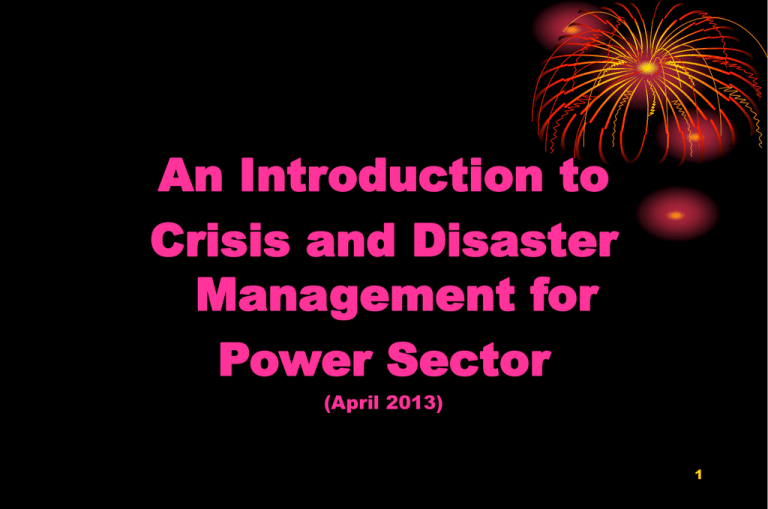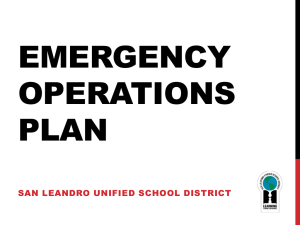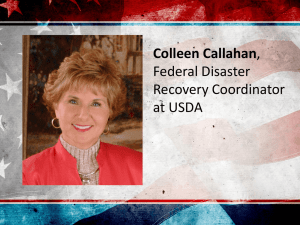Inaugural Session - Central Electrical Authority
advertisement

An Introduction to Crisis and Disaster Management for Power Sector (April 2013) 1 CRISIS: An Event of Acute Danger which can cause sudden disruption of power supply Caused either due to human error, equipment failure or sabotage. 2 DISASTER: Event which brings disruption to normal life including power supply Such situations are of greater calamity. 3 Role of Central/State Govts. • Administrative response to disasters is by and large responsibility of concerned state govt and/or state utilities i.e. Discoms • Intervention of Central govt. is sought in case of disasters of large mangnitude. • For power sector the term disaster is synonymous with crisis. 4 Objectives & Scope of DMP 1. It encompassed activities that enable utilities to: a. Plan for b. Quickly respond c. Recover from Disaster viz. Earthquake, Floods/cloud burst, cyclones, Hurricanes and crisis viz. i. Terrorist threat/attack & sabotage ii. Bomb threats & Explosion iii. Strike iv. Fire v. Cyber Threats 5 Contd. Objectives & Scope of DMP 2. Improve state of preparedness to meet any contingency 3. Reduce response time in organizing assistance 4. Identification of resources, man-power and equipment needed to make the plant operational 5. Making optimum use of combined resources 6 Outline of Topics Causes of Disaster & Crisis in Power Sector • Natural calamities • Man made Crisis situation 7 Outline of Topics Major areas prone to crisis, disaster in power sector •Thermal Power Stations •Hydro Power Stations •Electricity Grids, Load Despatch Centres 8 Disaster Management Plan for Natural Calamities Disaster Zoning for Natural Calamities • Zoning for Earthquakes • Zoning for wind load • Flood Plain Zoning 9 Contd. Disaster Management Plan for Natural Calamities Structure of 4 Tier Disaster Management System • Composition, responsibilities of Central/Regional/State/Plant level, Disaster Management Groups • Inter-Group relationship in Disaster Management System • Response Elements 10 Contd. Disaster Management Plan for Natural Calamities DMP for Hydro Electric Stations • Heavy Rainfall/storm in catchment • Landslide in reservoirs • Flooding in Power Houses 11 Contd. Disaster Management Plan for Natural Calamities • DMP : Thermal Power Plants, Failure of Electricity Grids, Restoration of transmission lines, sub-stations and Load Despatch Centres (LDCs) • Measures for quick restoration of Power Supply • Setting up of Control Rooms 12 Crisis Management Plan • Terrorists attack, bomb explosion, Physical Security Aspects • Safety measures for avoiding damage due to fire/explosion • Strikes by Plant Personnel • Training Needs 13 Contd. Crisis Management Plan • Emergency Safety Equipment • Facilities required to tackle any crisis/disaster, disaster management audit • Details of Nodal officers designated by utilities for crisis and disaster management 14 C&DM of Power Sector Apart from concerned CPSUs representatives of State GENCOs & IPPs also included in Committee Review of C&DMP OF POWER SECTOR •Incorporating provisions of DM Act (2005) •Guidelines of NDMA •Other related aspects 15 Contd. C&DM of Power Sector (Contd.) To formulate mechanism for annual updation Implementation of observations of DM audit National Policy on Disaster Management 2009 16 Role of POSOCO/NLDC MoP, in 2009 NLDC declared Central Control Room by MoP in case of Natural & Man made emergencies/disasters. ED SO/NLDC designated as Nodal Officer to coordinate for dissemination of information as per directions of CDMG 17 Issues for consideration • Mechanism for DM Audit for C&DMP of utilities • Effectiveness of Mock Drills by utilities • Uploading of Non-secret part of C&DMP on public domain • Capacity building for handling crisis & conducting workshop in association with NIDM etc. 18 Action by CEA C&DMP to be revised periodically IPPs/utilities brought in the purview of C&DMP Updated detailed list of designated Nodal Officers by various utilities. Details of 24 X 7 Control Rooms incorporated in the revised document with following three tier approach Contd. 19 Action by CEA (Contd.) Aspect on C&DMP for on going Projects Particularly Boarder Areas incorporated Quarterly reports are studied and furnished to MoP Flow chart of information in crisis situation Dos & Don’ts to be adopted by general public and general information to be put on public domain Dissemination of information and media management Aspects related to cyber security included Advisory issued to Utilities and State government for Preparation of DM Plans 20 Action by Utilities C&DMP to be prepared and updated regularly Capacity building and training by networking with knowledge based institutions to be included in document 21 Contd. Action by Utilities(Contd.) Role/responsibilities of various utilities as per DM Act 2005 and National Policy on Disaster Management 2009 to be incorporation in the revised document In line with the directions of Secretary (Security), Cabinet Secretariat Mock Drills to be conducted by utilities & report submitted to CEA/MoP. 22 THANKS 23







